If you’ve read many of my trip posts you’ll know that I really enjoy taking my dog, Hunter, with me on many hikes. Hiking and backpacking with a dog change the dynamic of the trip and changes the necessary planning. The hike becomes the dog’s hike rather than your hike and there are several changes to be aware of. Here are several things to consider. Despite the extra rigor – taking the hound hiking is great!
Before you start hiking with your dog
- Check with your vet – make sure your pup is older enough and has all the necessary vaccinations. Make sure to discuss suitable medication for ticks and fleas.
- Make sure your dog is suitably fit for hiking – this depends both on the breed and current level of fitness. A younger dog may have boundless energy and be able to hike for multiple days, whereas an older dog or smaller dog may struggle to pile on the miles
- Check that you can actually take the hound with you! This requires some research into the policies of the agency where you are planning to hike. National Parks are very dog unfriendly, and National Forests are very dog friendly, as in BLM land generally. State and city lands vary so much it’s best to check.
General considerations for taking a dog with you
Now that you have the basics taken care of and decided to take your pup on your next trip – let’s start looking at some of the planning changes.
- Be very mindful of the trail you select. This is both in length and difficulty. Start with a small overnight hike and then build from there. Consider the challenges on the trail. Forest trails tend to be easier than those that are either rocky or sandy, which can get hot. Water/river crossing can pose a particular problem where you may have to carry your dog across.
- Generally taking a pup or two will add to the weight needed. We’ll cover a little later additional gear you might need and this includes a pack for the dog, but even so be mindful that just like you, you have to be careful not to overload your dog and they need time to get used to wearing a pack.
- If your pup is like Hunter, he’s a luxury indoor dog when he’s at home, so expecting him to sleep on a cold floor when he’s out camping is unreasonable. Other dogs are more used to being outside.
- Be more mindful of the weather. I wet dog will need drying to keep both warm and stop the inside of your tent from becoming damp too. Hot weather can really tire a dog out quickly. If you are considering taking your pup into an alpine environment, or substantially snowy environment in summer, remember that they can also suffer from snow blindness and seriously consider snow goggles – although this would be unusual.
So what might you need – harnesses

You’ve got the basic plan together – let’s talk a little about what extra kit you might need. First off when we go hiking or backpacking Hunter always has a harness rather than his normal collar. There are a couple of reasons for this. The attachment point is on the top of the harness which generally keeps the leash clear from his paws. If I think the trail is going to be at all difficult I use the harness that has a carry handle on top – this is great if I need to help guide him across logs or carry him across streams.
Hunter, looking quite professional, in his Ruffwear front range harness. A lot of his gear is Ruffwear and this has worked really well. This is a lightweight harness and just has more control than his regular collar. I only use this for day trips.

If we are going on longer backpacking trips where we will be out overnight then he has his own backpack. This gives a little extra space for him to carry some of his own gear. Hunter’s a pretty small dog (40lbs) so I generally limit what he carries to about a maximum of 6 or so pounds. The Approach Pack, also by Ruffwear, has two sets of pockets on each side. The top pockets are good for small items (like dog bags) and the deeper pockets are good for his food. Particularly important is the handle which has come in handy many times.

You can also see that he has a springy leash. Regardless of the leash laws (and National Forests are pretty lax), he’s almost always on a leash (the only exception is sometimes in camp at the end of the day). As there are more dogs on the trail this just makes sense to keep encounters with people and other dogs under control. His leash has some spring in it to ensure that if it gets caught or Hunter jumps a little further than I expect then there is some give in the leash. Even though this is technically a running leash I rarely wear it around my waist and just use the extra loop to make the leash a little longer.
I have two other packs for Hunter. One is a life jacket that he only has if we decide to go out on the paddleboard (he’s a lucky dog). The other is an insulated jacket. I generally only use the insulated jacket on day hikes in winter, especially if we are going to play in the snow. This jacket we have had for some time (I think it was actually a hand-me-down from his elder cousin). Again Ruffwear have you covered if you need an insulated jacket.
That pretty much covers what Hunter has to wear. Making sure they are sized properly is important.
Keeping your dog warm at night
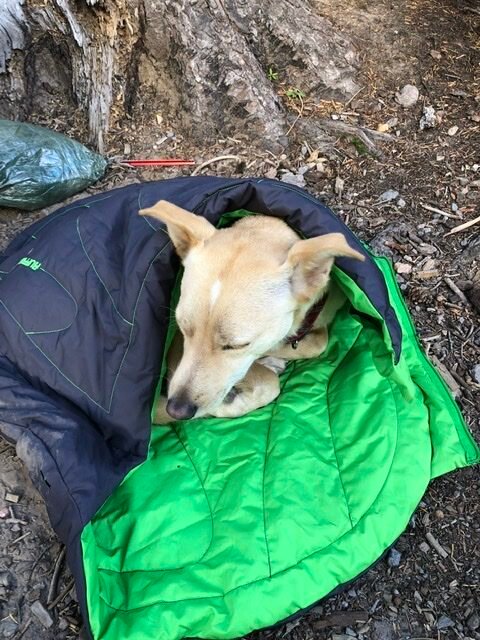
Let’s move on to what he has to sleep on. He sleeps in my tent and I have never had a problem with him either damaging the tent floor or being overactive in the tent. He actually has his own sleeping bag. I do find this a little bulky and heavy at around 2lbs – and I normally get to carry this so it also takes up room in my backpack. However, it’s really convenient to be able to throw it on the ground when we are in camp and have somewhere where he can quickly settle – as you can see his pretty happy. In summer this is pretty much warm enough and I’ll just shake this out and then put it in my tent.
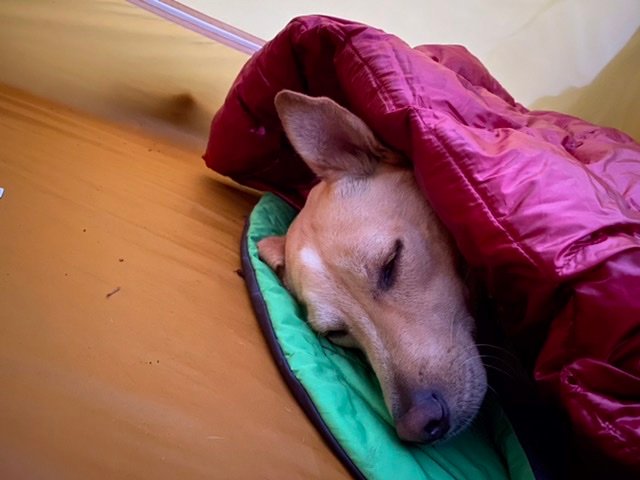
If it’s a little chillier I’ll add two extra items. The sleeping bag has a space for a pad and although Ruffwear has one that fits perfectly inside – I think that half a closed-cell foam pad works just as well. I just cut an old one I had in half. Then if it’s super cold I have a down comforter that I got from Costco for the bargain price of $25. Unfortunately, they don’t seem to stock these anymore. All together they make quite the cozy sleep system for Hunter,
Despite all this to make sure he’s warm – there still is the occasional night where I seem to wake up and find him under my quilt and on my pad! You can’t beat backpacking with your hound!
What else might you need?
You pretty much have most of what you need at this point. But there are a few more things you’ll need. One essential is a dog bowl. Again we have a Ruffwear bowl that works well for both an eating and drinking bowl. Many folks will also take booties for their dog. These might be necessary if you are going over sharp rock – but I’ve never had the need for them. Hunter is mainly on the trails around Mount Hood and these are quite a mixture of wooded, sandy, and the occasional rocky trail beds. If you do feel the need for booties make sure your dog is comfortable with them before you head for the trail. Have pup wear them for a while.
You can also look for a dog’s first aid kit. However many of the items in your own first aid kit work well for dogs on the trail, Just make sure you know the correct doses. Here’s a great article on basic dog first aid. For me, the biggest concern is heat exhaustion. So make sure to keep your pup well hydrated.
And now out on the trail!
It’s finally time to get out on the trail. Here are a couple of final tips.
- I generally keep Hunter on a leash. This keeps him under control, especially if he meets other dogs who may not be so friendly, and keeps him from disturbing other hikers. In other areas, snake bites can be a problem – so knowing where your dog’s nose is can be helpful. Evacuating a dog in an emergency can be a real hassle.
- What to do when your dog poops? There are only two options – bag it up and carry it out (I’ll have the dog carry it out), or burry it as you would human waste in a cat hole, away from water. Please do not put it in a bag and leave it by the side of the trail – even if you do plan to pick it up late. This is unsightly and often just left.
- Do you let your dog drink from streams? Well, this is sometimes hard to void. Dogs can catch giardia just like humans. However, as a general rule, I’ll let Hunter drink from a high-up, fast-moving stream, and keep him away from lower-down, slower-moving water. Often he’ll just get my filtered water.
- Generally, I pack extra food. It’s as strenuous exercise for the dog as it is for the human, so I’ll bring along about an extra 50% per day. I don’t change his food for hiking. I do hang his food at night.
- Read how your pup is enjoying himself. If you hike with your dog it really becomes his hike. Is he getting tired, is his tail down? If he looks like he’s getting weary then it’s probably a good time to set up camp for the night.
- Check pup at night for ticks and pad problems. You can help avoid ticks with preventive medications beforehand – but if you find a tick then remove it, Make sure his pads are not cut or bruised.
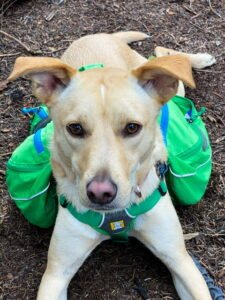
The longest trail Hunter has done so far is the Timberline Trail. This is about 40 miles, 3 nights, and 4 days. Beyond this food, weight becomes a bit of a challenge, although there are plenty of folks who take the dogs on longer thru-hikes. Backpacking with your dog can be one of the best experiences!
As a final note – there are a lot of links to Ruffwear products – Hunter has almost all of these (except the booties) and they have all worked really well. So they come dog recommended,

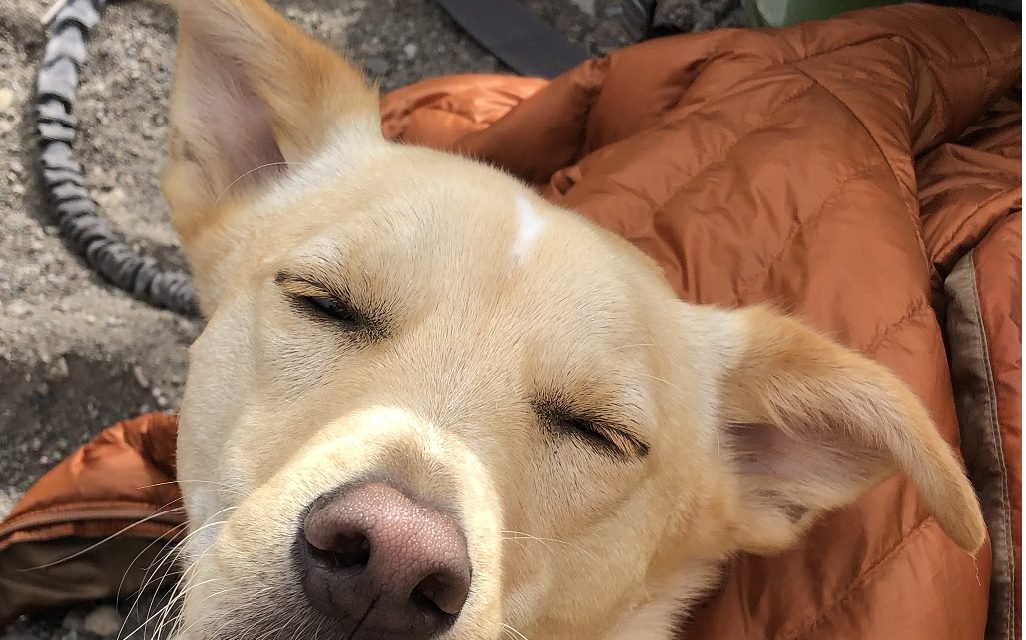
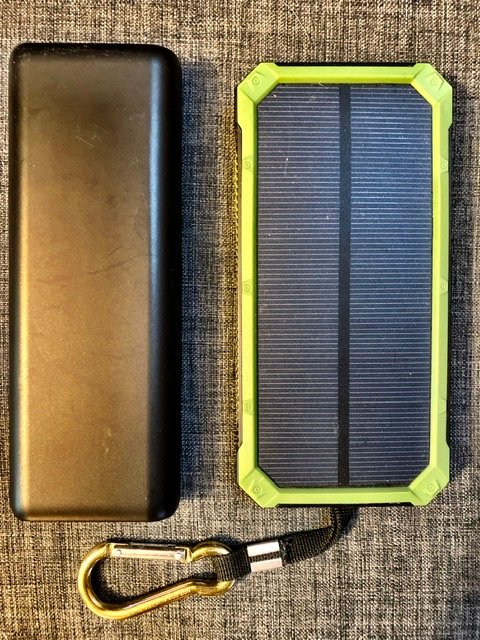
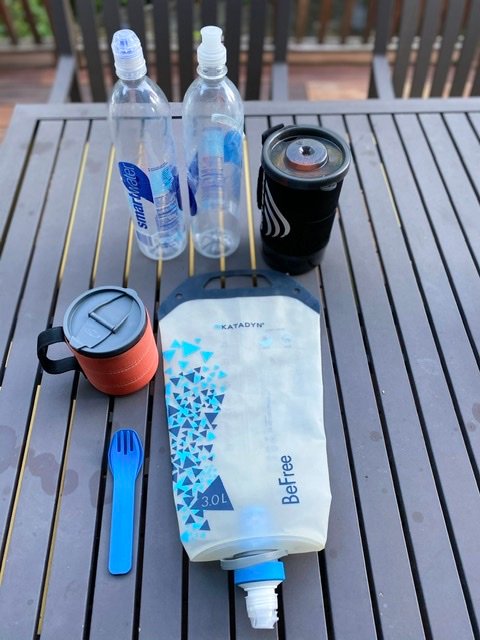
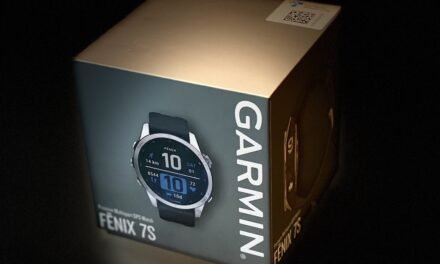


How did you do the JMT with a dog since much of it is in Yosemite and SEKI which do not permits dogs
Hey Mike – I’ve not done the JMT with Hunter – as you point out some of it is in National Parks which don’t allow dogs on trials – and personally I wouldn’t be comfortable taking him on a long thru hike – it would get logistically much more challenging. The longest hike I’ve taken Hunter on is the Timberline Trail – which is about 42 miles, 3 to 4 days. I think personally I’d stop where you get into resupply questions – but many folks of course takes their pups on longer hikes. – Matt